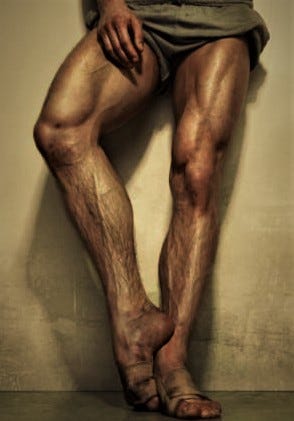Ballet Dancers Have Muscles You Don’t.
by Tom Furman

Anatomically, dancers have the same muscles you do. However due to the movements involved, they have hypertrophy in areas that many athletes don’t. Let’s take a look at what they do and how to distill it for your own use.
There are seven primary movements in ballet. Styles of ballet vary between origin and teacher.
These are the movements -
Plie’, plier. To bend.
Releve’, relever. to rise.
Tendu, etendre. To stretch.
Glissade, glisser. To glide.
Saute’, sauter. To jump.
Elance’, elancer. To dart.
Tourne’, tourner. To turn.
While this history and technical exposure lays a foundation, it hardly gets to the point of leg development and the methodology needed to reap benefits.
There is, because of the nature of movement, more development around the calf and hips. Taking these muscles, even under bodyweight tension, through a great range of motion stimulates hypertrophy. I’ll repeat, other than therapy or specialized training, the bulk of a dancer’s training is bodyweight only. Obviously any bodyweight movement can be enhanced with augmented resistance, however learning to strengthen the proximal and distal positions has merit.
Look at the range of motion and how it represents both flexibility AND strength.


Rather than present endless images of impossible strength, development and range of motion, let’s focus on what can be done to jumpstart new development and strength.
First, here is some anatomy of the upper leg. There is more muscle in there than you think. Naysayers will claim that the muscles are hidden to a degree, but when sufficient adaptation occurs, unusual development occurs.


To reduce complexity or moving in tangents, let’s use a few exercises tacked on to the end of your leg workout. This serves several purposes -
- It’s not too much, so you don’t skip it.
- You are already warmed up. The hips, knees and ankles are ready to go.
- Because you have already lifted heavy, little work is needed to get an effect.
- The movements will shore up weaknesses and increase balance.
Exercise ONE. Plie’ Squat. You will never have the turn out, adductor flexibility or abduction strength of a professional dancer. Don’t worry. Simply hold onto a support with feet shoulder width apart. Toes should be turned out only as far as is comfortable. Turn outs are primarily a hip movement. Now squat as deeply as your flexibility allows while keeping the heels on the floor. This should be done slowly, much more slowly than the normal gym lifts. Maintain posture and don’t bend at the waist. Repeat until muscular failure. Shake your legs out and move on to #2.

Exercise TWO. Grand Plie’ Squat. This is a variation of the first drill. However you will start with your feet close together and lower the body while squatting on the toes. This will take you deeper for more leg stimulation and calf strength. Again, work to failure. If the repetitions get unwieldy, add a dumbbell in your free hand. Always hold onto a support during these squats.

Exercise THREE. Arabesque Deadlift. This is basically a one legged deadlift. The difference is in the lifting action of the rear leg. You actively flex the butt and hamstring rather than letting it just go along for the ride. Finish one leg before doing the other. Do not alternate. One set of 15 to 25 repetitions should be sufficient. In the photos below, note the similarities. Use a light weight to start and realize it will take some practice to manage your balance and have smooth movement.


Exercise FOUR. Adductor Calf Raise. Keep the toes straight ahead and pinch a ball or yoga blocks between the calves to fire adductors and enhance alignment. You can hold a weight in one hand to limit overly high repetitions. Your toes should be on a block or step. Do 20–50 SLOW repetitions from extreme stretch to extreme contraction.

Exercise FIVE. Side Extension Series. No one can expect extreme extension of the legs to the side without devoting a lifetime to it. However this position and the muscles involved are poorly developed in athletes other than gymnasts and dancers. You will need to hold onto a bar and raise your upper thigh parallel to the floor. Let the lower leg hang freely at first. Abduct the thigh as much as possible, moving it to the side of the body. Now with the toes pointed, extend the lower leg while keeping the knee motionless. You should lock out the knee and hold it for a slow count of THREE. Lower it slowly and repeat until muscular failure. Do not lower the knee, but with the leg hanging freely at 90 degrees, trace circles with the toes in the air. This stimulates the hip and the internal/external rotators of the thigh. Do 30–50 circles in each direction. The knee is motionless and the lower leg is moving in a small circle. Do one leg, then the other. Again, this will be quite challenging in the beginning. In later stages, raising the thigh higher or adding leg weights can help you advance.

This completes the workout. All exercises are one set only. This is a, ‘tack on’, type of routine to slowly introduce you to new movement and expose weaknesses. The enhanced strength and range of motion may benefit your athletic endeavors or stimulate strength and hypertrophy. Try it. Do it after your leg workouts, but no more than two times per week.
The genesis of this article is rooted in my former career as a stagehand in Miami, Florida. During this time I was lucky enough to watch male leads such as Mikhail Baryshnikov, Fernando Bujones, Rudolph Nureyev, Alexander Godunov and the great Edward Villella dance. It was the expression of Edward as a protege or ‘Prodigal Son’ of Balanchine that piqued my interest in the athletic transfer of dance. Edward played baseball and boxed during his early athletic career. He brought it all together during his dance. Thank you, Edward.


